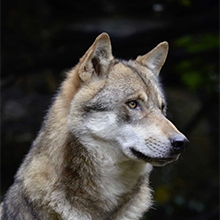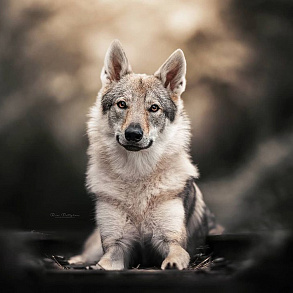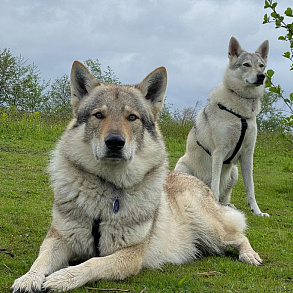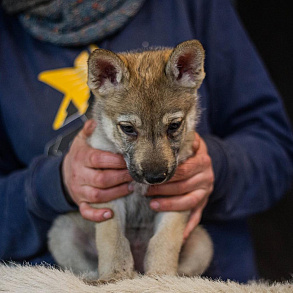Czechoslovak Vlchak

Czechoslovak Vlchak (Czechoslovak wolf dog) is a large dog with universal working qualities, bred by crossing a German Shepherd with a Carpathian wolf. To date, it does not belong to hybrid breeds. It belongs to the group of herding and cattle dogs.
- Brief information
- Highlights
- Breed characteristics
- History of the Czechoslovak Wolf Dog breed
- Czechoslovak Vlchak breed standard
- The character of the Czechoslovak Vlchak
- Education and training
- Maintenance and care
- Health and diseases of Czechoslovak wolf dogs
- How to choose a puppy
- The price of Czechoslovak vlchak
Brief information
- Breed name: Czechoslovak vlchak
- Country of origin: Czechoslovakia
- Weight: males from 26 kg, bitches from 20 kg
- Height (height at the withers): males from 65 cm, females from 60 cm
- Life expectancy: 12-15 years
Highlights
- The right to be considered the birthplace of the breed is shared by two countries – the Czech Republic and Slovakia, since the formation of the phenotype occurred during a period of time when both states were part of the Czechoslovak Republic.
- Like all dominant breeds, Czechoslovak Vlchaks do not get along well with their fellow tribesmen, so it is better to select opposite-sex pairs of pets for keeping on the same territory.
- The high level of intelligence of the Czechoslovak wolf dog does not allow it to follow the path of blind submission, which complicates the training process.
- The opinion that Czechoslovak Vlchaks do not know how to bark is a mistake. In fact, animals prefer other ways of communication – body movements, whining, howling. Dogs try to make barking sounds only on special occasions, which gave rise to the corresponding stereotype.
- The breed is characterized by courage and the ability to make independent decisions in extreme situations. For example, unlike the wolf dog Sarlos, the Czechoslovak Vlchak does not retreat in the event of a real threat, so you can successfully take the ZKS courses with him.
- Physical inactivity and boredom do not threaten the owner of the Czechoslovak vlchak. The dog needs systematic loads, as well as long walks, compensating for the lack of motor activity with destructive behavior and annoying howling.
- The crossing of the ancestors of the Vlchaks with the Carpathian wolf increased not only the endurance, but also the life expectancy of the animals up to 15-18 years.
- The Czechoslovak wolf dog is a great pet for "remote workers" and a very bad option for owners working outside the home. The fact is that representatives of this breed categorically do not tolerate separation from a person and, remaining alone, arrange pogroms in the dwelling.
Czechoslovak vlchak is a confident leader and devoted companion, with whom the owner's everyday life will always be extremely intense. Finding the key to the heart of this gray intellectual is not as difficult as it may seem at first glance. The main thing is to immediately let the pet understand that he will not be the senior companion in any endeavors. Constant communication with a person, as well as an active lifestyle are the main pleasures for the Czechoslovak Vlchak. The key to comfortable coexistence with the breed is, first of all, the desire to contact the animal, anticipating its needs and aspirations.
Breed characteristics
History of the Czechoslovak Wolf Dog breed
Vlchak is the "result" of a carefully planned experiment conducted by a group of Czechoslovak breeders in 1955-1965. The reason that prompted dog handlers to create a new breed was the increased need for guard dogs capable of serving at the border. In most European countries , this work involved german shepherds , which at that time had one serious disadvantage – the breed was retiring too quickly. As a result, even healthy 8-year-old individuals could not compete with young sheepdogs: the animals lost their visual acuity and sense of smell, got tired quickly, and showed a slow reaction when detaining violators.
To get more hardy "service dogs", German Shepherds decided to cross with Carpathian wolves. The project manager was Colonel and cynologist Karel Hartl, who had previously been engaged in "pumping" the phenotype of Czech terriers. The first hybrid litter of puppies was born in 1958 – his parents were a wolf Brita and a male German shepherd Cesar. For the second time, the dog Kurt became Brita's partner, whose offspring also turned out to be viable and fully met the requirements. Further experiments on breeding wolf dogs continued in a slightly modified form: a bitch became the mother of puppies German shepherds , and the father is a Carpathian wolf.
By the 80s, the Czech Vlchak had smoothly transformed from a purely service breed into a universal one. The formation of the working qualities of its representatives began to be engaged not by the military, but by dog handlers, which also left its mark on the temperament of the animals. In 1982, the descendants of the Carpathian wolf and German Shepherd their own club appeared, and 7 years later the final version of the breed standard was approved for them.
An important nuance: since for several decades the breeding of Vlchaks has been taking place only "in itself" (the last crossing with a wolf took place in 1983), they are not classified as potentially dangerous for humans hybrids of the wolf-dog type.
Video: Czechoslovak vlchak
Czechoslovak Vlchak breed standard
All members of the family have a strong external resemblance to wolves, but differ from the well–known half-breeds - wolfsbane and Wolfhound. According to the type of constitution, Czechoslovak Vlchaks are closer to sheepdogs, so they have a less animal-like appearance than real hybrid individuals. The minimum allowable height for a male is 65 cm; for a female – 60 cm. Sexual dimorphism is also reflected in the weight of animals. If a male Czechoslovakian Vlchak cannot weigh less than 26 kg, then for "girls" this is more than a decent bar, since for them the lower limit of body weight is only 20 kg.
Head
The skull is arched, rounded in front and from the sides. With a pronounced occipital protuberance, the frontal furrow is smoothed and practically invisible. The stop is medium-relief, the narrow muzzle is complemented by a straight bridge of the nose. Cheekbones without a characteristic bulge, but muscular and developed.
Nose
The lobe fits perfectly into the shape of an oval. The skin color of the nose is uniform black.
Lips, jaws, teeth
The lips closely adjacent to the jaws do not form hanging "pockets" at the corners, and their edges are painted in a rich black tone. Symmetrically positioned jaws close into a straight or scissor bite. The teeth are large, with massive developed canines. The number of teeth approved by the standard is 42.
Eyes
The Czechoslovak Vlchak should have oblique and small-sized eyes, with an amber-tinted iris. The eyes are covered with dense dry eyelids.
Ears
Short, classic triangular shape. The thin ear cloth is always kept in a standing position. An important breed feature: an imaginary straight line can be drawn between the outer corners of the eyes and the outer corners of the ears.
Neck
The neck of the Czechoslovak wolf dog is elongated, dry, with dense, well-felt muscles. The norm of neck tilt to the horizon is up to 40 °.
Housing
The Czechoslovak Vlchak is distinguished by a strong build and quite tall. The dog's back is flat, with a slight slope. With pronounced withers, the topline is as smooth as possible. A short, non-spreading loin connects with an almost horizontal, well-developed and equally short croup. The pear-shaped chest is not lower than the level of the elbow joints, the front part of the chest never protrudes beyond the shoulder line. The belly, sunken from the sides, is strongly tightened, which gives the silhouette of the animal a pleasant grace.
Limbs
The front legs of the dog are located close to each other, while the paws are slightly turned outwards. The blades form an angle of about 65°. The shoulders are developed, the elbows are mobile, strong, hold tightly to the body. The forearms and pasterns are elongated.
The hind limbs of the Czechoslovak wolf dog are quite powerful, parallel to each other. Massive long hips form an angle of 80° with the pelvic bones. Flexible knee joints turn into muscular long shins. Articular joints are strong, with angles of 130 °. The metatarsals stand almost vertically.
The dog's paws are elongated, with arched fingers ending in strong black claws. The animal moves ambling (in a calm state) or trotting (in an excited state), stretching its neck and head forward.
Tail
High landing, hanging down. In an excited dog, the tail takes the form of a sickle and rises.
Wool
The Czechoslovak Vlchaks have a pronounced seasonality of cover. In winter, the coat is thick with a plump layer of undercoat, which is noticeably larger than the outer hair. By summer, the volume of the undercoat decreases, but the cover hair remains quite thick and dense.
Color
A suit of any tone is possible in the range from silver-gray to yellowish-gray. There is a light mask on the Vlchak's muzzle. Other areas with bleached hair: chest, inner part of the neck. Not always, but a dark gray color with a lightened mask is allowed.
Disqualifying vices
- Cowardice or emphasized aggressiveness of behavior.
- Loss of teeth (the absence of two RM1, one M3 is not counted).
- Fragile ligaments.
- Any color, except those fixed in the standard.
- Irregular skull shape.
- Croup with a sharp slope.
- The presence of suspension.
- Wool does not adhere to the skin, has a soft or wavy structure.
- Incorrectly planted tail.
- Ears of atypical shape, planted too high or low.
- The eyes are not oblique, but rounded.
- Incorrect placement of the legs or the shape of the chest.
Exterior defects for which the Czechoslovak vlchak receives a low score at the exhibition: flat forehead, unexpressed mask, short undulating movements, weak musculature. The iris of a dark brown tone, mismatch, too heavy or light head are also penalized.
Photo of Czechoslovak vlchak
The character of the Czechoslovak Vlchak
Thanks to competent breeding work, the Vlchaks did not turn into ferocious brutals with the habits of forest predators. Moreover, they absorbed only the best qualities of wild ancestors – amazing endurance, sharpened intuition, high intellectual indicators. However, living side by side with a representative of this breed imposes a number of obligations and is in many ways different from co-existence with the German Shepherd . As an example: Czechoslovak Vlchaks have phenomenal suspicion, and alertness and readiness to repel an attack extend to any strangers. Accordingly, if a new family member has appeared in the house, the animal will not be able to get rid of the feeling of distrust towards him soon.
The Czechoslovak wolf dog is selflessly devoted to its own owner. However, it should be clarified here: the pet will adore the person who proved his worth and did not allow the animal to "steer" the situation. If other "tails" live in the house, vlchak will definitely try to climb to the top of the hierarchical pyramid in order to command from there all those who allow themselves to be subordinated. The dog will try to turn small-sized pets into prey if it is not stopped in time, so guinea pigs and domestic rabbits definitely do not belong on the same territory with the Czechoslovak Vlchak.
In addition, this is one of the breeds whose representatives do not have a special love for children. A child in the understanding of a wolf dog is a creature standing at a higher stage of development than a cat, but much lower in level than an adult. Having a Czechoslovak Vlchak in a family with small children is an unjustified risk, especially if the relationship between the kids and the pet is not controlled by adults. Remember that representatives of this family react extremely painfully to disrespectful attitude from the children. So if a descendant of the Carpathian wolf lives in the house, explain to the children that hugging, dragging by the tail and riding a lying pet on horseback are fraught not only with torn shoes, but with a trip to the emergency room.
Today's Czechoslovak Vlchaks are versatile dogs, capable of both guarding housing, and repelling an attacker, and setting the tone in agility. However, in order for all these skills to "work" correctly, instincts alone are not enough – professional training is necessary. Ordinary dog pranks are also not alien to animals. And since the Czechoslovak Vlchaks are ahead of most breeds in intellectual terms, then their leprosy turns out to be more thoughtful. For example, teenage dogs masterfully open the doors of kitchen cabinets and gates, masterfully steal food, and also leak into any holes that do not correspond to their dimensions.
Education and training
On your mind – this is about how you can characterize the behavior of a Czechoslovak wolf dog when it has to be included in the educational process. On the one hand, Vlchak is intellectually gifted, so he comprehends the basic "wisdom" much faster than the same shepherds. On the other hand, the breed is disgusted by useless activities, to which its representatives refer any repeatedly repeated commands and requirements. You need to train a dog very carefully, without trying to mold it into an ideal "service dog".
Often owners who do not have experience in raising dominant breeds give the animal to cynological centers for individual lessons with specialists, and they themselves are completely eliminated. However, the results of such training can be unpleasantly surprising. For example, many organizations do not take into account the wild genes of Czechoslovak Vlchaks, applying to them the same methods of education as to German shepherds . As a result, the dog turns into a controlled "robot" with psychological problems that will sooner or later make themselves felt. Therefore, if you do not have enough of your own strength to train a vlchak, contact a specialist, but always attend classes and monitor the emotional and mental state of the pet.
If you do not plan to raise a guard dog from a pet, you can neglect the ZKS course. But the OKD is worth going through, even if your dog is an ordinary pet. Czechoslovak vlchaks work only for motivation, and each individual has a different one: someone is ready to execute a command for a treat, and someone will have to pick up another key, which, most likely, will not work the first time. The usual difficulty of Vlchak breeders is working out the command "Voice!". The fact is that this highly intelligent breed rarely uses barking, preferring other ways of communication to it. As a result, it takes more time and effort to master the skill than expected.
Stubbornness and unwillingness of the pet to engage should also be perceived adequately. Any Czechoslovakian wolf dog has a period when it wants to control others – usually it is the time of puberty. In such cases, it is better to loosen control a little, give the animal a little more freedom and more often switch his attention to other activities – games, sports, just walking. However, it is not necessary to concede the throne of the leader to the "tail" under any pretext – the descendants of the Carpathian wolves are cunning and will not miss the opportunity to play on the master's weaknesses. Claudia Fugazza's book "Do as I Do" will also be a good help in training. The author has many years of experience working with Czechoslovak Vlchaks. Many of the techniques described in the book have been successfully worked out on this breed.
Maintenance and care
There is an opinion that the Czechoslovak Vlchak is a dog that values freedom and does not take root in city apartments. In fact, the breed is not as demanding of space as they like to attribute to it: a regularly walked animal that receives the necessary physical activity and enough master's attention behaves calmly and unassumingly. Breeders claim that the physically laid out vlchak generally "merges" with the surrounding interior.
Loneliness for the Czechoslovak wolf dog is the number one phobia, which is not treated, but can be slightly corrected. Of course, leaving a ward for half a day without receiving torn curtains as a "bonus", as well as neighbors' complaints about infernal howling is an impossible mission. But it is quite realistic to train an animal to spend an hour or two without an owner in a disciplined manner.
At first, the cage will help to avoid apartment pogroms. But keep in mind that standard Czechoslovakian vlchaks quickly "disassemble" for spare parts, and the latches manage to open, so pick up the most durable and protected from dog teeth shelter. In suburban conditions, such a movement limiter will be an aviary that can be built independently, or you can order it ready-made.
The minimum required number of daily walks for a Czechoslovak Vlchak is two, lasting 1.5 hours each. You can walk more – walk, less – no, if you don't want a hurricane living at home, turning it upside down. To help the dog discharge, involve her in games and sports, come up with new areas of activity, for example, sledding, running behind a bicycle, easy towing of objects.
Hygiene
It will be necessary to work with the thick dense wool of the Czechoslovak vlchak minimally. Twice a year, the breed sheds profusely, but the hair does not fall out, but simply lags behind the body. At this time, the pet must be combed daily, and the dead undercoat must be cleaned with a fluff. Vlchaks do not need frequent bathing: their "fur coats" repel dust remarkably and do not absorb liquid dirt. As a result, all impurities remain on the top layer of the dogwood and are removed from it naturally. It is best to wash the dog during the molting period: it is easier to remove the lagging undercoat.
It is necessary to bathe puppies more often: small vlchaks are not particularly neat and often get dirty in bowls with food, as well as their own excrement, turning into a walking source of unpleasant odors. Little sluts are not treated with special means, so as not to remove the protective grease: it is enough just to wash off the dirt from the wool with a stream of warm water. Cleaning the ears with special drops and lotions is carried out only when sulfur accumulates. Just like that, "polishing" the hearing organs of the Czechoslovak Vlchak is not only useless, but also harmful.
The breed's eyes are healthy, so the only hygienic procedure recommended for them is preventive wiping with a clean cloth soaked in chamomile decoction. Brushing teeth is also desirable, but it is not always possible to accustom a Czechoslovak wolf dog to it. If the number with toothpaste and a brush did not pass, use auxiliary means: solid treats that work as abrasives, tomato juice or ready-made preparations for removing plaque added to drinking water.
Feeding
Both natural food and industrial dog food have both fans and opponents. Although experts who have been working with the breed for a long time recommend making a choice in favor of natural products. The fact is that the body of Czechoslovak Vlchaks does not digest starch, which is often added to the "drying". As a result, switching to industrial feed can be accompanied by diarrhea and other unpleasant symptoms. You will have to choose a brand suitable for a dog exclusively by experience, which is not always convenient. As a rule, there are no problems with a natural diet, unless you transfer a pet from dry food to it. In this case, the adaptation period, accompanied by a digestive disorder, is quite likely.
The nutritional base for the Czechoslovak wolf dog is meat and its waste: cherished nonconditioning, cartilage, scar. Puppies whose teeth change, it is sometimes useful to gnaw a sugar bone. Once a week, instead of meat, it is allowed to give sea fish without bones. Cereal porridges on meat broth are not prohibited, but their share in dog food should be small, about 20%. Veterinarians also advise supplementing the natural menu with vitamin complexes, but, as the experience of breeders shows, sometimes special preparations can be replaced with more affordable products. It is usually recommended to "fortify" the diet of Czechoslovak Vlchaks with chicken yolk, brewer's yeast, linseed oil, fish oil.
Health and diseases of Czechoslovak wolf dogs
The genes of the Carpathian wolf made the Vlchaks hardy, but they only partially got rid of the diseases inherent in other ancestors. For example, the breed has a predisposition to hip dysplasia. It is also found among Czechoslovak Vlchaks and pituitary nanism (dwarfism) – puppies are born with an underdeveloped pituitary gland, suffer from dwarfism, insufficient thyroid function.
Progressive retinal atrophy passes to some individuals from their parents: the nature of inheritance is autosomal recessive. Rarely, but still there are dogs with degenerative myelopathy, the first symptom of which is the dragging of the hind legs. The disease is not treated and is transmitted to offspring even in cases when only one of the producers suffers from it.
How to choose a puppy
- Czechoslovak vlchak bitches are less adventurous and more manageable than males, so if you want to make it easier for yourself to train a pet, choose "girls".
- The optimal age of a puppy for purchase is 2-3 months. It is undesirable to take more adult individuals due to the fact that the older the animal, the more difficult it is to socialize and educate it "for yourself".
- If breed exhibitions are planned, scrupulously study the documents of litter producers: examination for the presence of genetic diseases, results of psychological testing (T1), data of the bonus code.
- Don't buy a wolf dog puppy right away. It is better to book the baby and visit him several times – so you will see how the Czechoslovak Vlchak develops, what character traits it acquires.
- Choosing the most active and courageous puppy, remember that leaders grow out of such individuals, who then have constant problems with obedience.
- It's great if at least one of the litter producers comes from Czech nurseries, since the best representatives of the breed still live on the territory of the former Czechoslovakia.
- Ask if the seller is ready to provide consulting support to his customers. In serious kennels, puppies are usually "led" throughout their lives, which is especially valuable for novice fans of the breed.
Photos of Czechoslovak vlchak puppies
The price of Czechoslovak vlchak
The cost of a Czechoslovak wolf dog puppy from famous manufacturers is from $600. It is better to look for purebred representatives in official nurseries like "Romtat", "Malakhovsky Wolfhound" and others. The cheapest, and sometimes even free option is adult individuals, which are often sold through virtual bulletin boards. Typical reasons that encourage owners to get rid of wards are zoo aggression, moving to a new place of residence, a busy work schedule that does not allow controlling the behavior of the dog.


